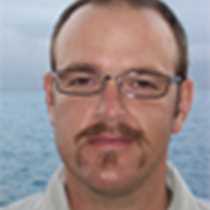An early morning visit to Floreana brings us into direct contact with one of the most historically significant island in Galápagos. Here Ecuador ceremoniously took possession of Galápagos in 1832 and this is also where we had some of our first colonist attempts from the early 1800s on.
We start the day at Cormorant Point, which is a combination of volcanic cones jutting out from the coast with a large brackish pond directly behind our landing beach. Immediately we encounter sand that has a brownish tinge that upon closer inspection shows olivine crystals from its volcanic past sparkling in the morning sun. A short distance from the landing area a brackish pond opens up and we find black-necked stilts and greater flamingos wading and feeding in the pond. A contrast of colors awakens us to the fact that there are certain species such as the Floreana daisy that are found on this island and nowhere else on earth.
As we head to the windward side of the island we find Palo Santo incense trees and mesquite lining the path, with Darwin finches flitting about. White coralline sand welcomes us to a small beach and a Pacific green sea turtle nesting area that contains large indentations in the back of the dune area. Frigatebirds patrol high above the path as we return to our ship and to a hearty breakfast. Captain John repositions the ship close to Champion Island. We have a chance to search for the Floreana mockingbird, which is in danger of extinction due to invasive species being brought to Floreana through its human history. Currently there is a grand project to restore Floreana back to its pre-human history and eventually reintroduce the Floreana mockingbird back to its original range.
Snorkeling ensues and we find that the water holds many surprises below its surface. Sea lions continue to use us as a source of entertainment and we find large aggregations of King Angelfish, Dusky chubs, Cortez chubs, and Creole fish that surround us as we swim along the coast.
One last repositioning of the ship brings us to Post Office Bay on the western coast of Floreana. Captain James Colnett described this area in detail at the end of the 18th century. A post barrel was placed here to facilitate correspondence from England and the whalers here in the archipelago. Many leave postcards to be delivered. This is the oldest postal system in the Americas and the Pacific Ocean region and still operates as guests take postcards so that they can hand deliver them as it always has been done.
Kayakers explore the coast along this picturesque area that has had a wide range of different visitors in the past centuries. Zodiac riders also explore and all are content with the sightings of pelicans, herons, and sea lions. As the sun dips into the horizon we are treated to a view of the Galápagos penguin, which has a very small population on Floreana of just a few individuals.
This has been a successful day learning of human history and conservation efforts with phenomenal wildlife sightings.







